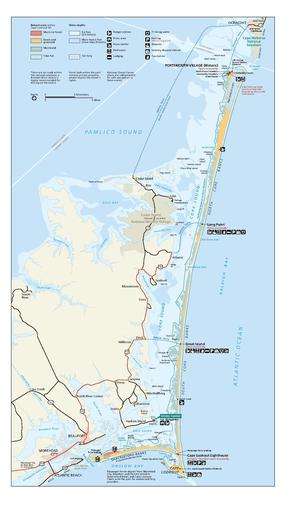Cape Lookout National Seashore
| Cape Lookout National Seashore | |
|---|---|
|
IUCN category V (protected landscape/seascape) | |
|
Cape Lookout Lighthouse | |
 | |
| Location | Outer Banks, Carteret County, North Carolina, United States |
| Nearest city | Harkers Island, NC |
| Coordinates | 34°36′19″N 76°32′11″W / 34.60528°N 76.53639°WCoordinates: 34°36′19″N 76°32′11″W / 34.60528°N 76.53639°W |
| Area | 28,243 acres (11,430 ha)[1] |
| Established | March 10, 1966 |
| Visitors | 508,116 (in 2011)[2] |
| Governing body | National Park Service |
| Website | Cape Lookout National Seashore |

Cape Lookout National Seashore preserves a 56-mile (90-km) long section of the Southern Outer Banks, or Crystal Coast, of North Carolina, USA, running from Ocracoke Inlet on the northeast to Beaufort Inlet on the southeast. Three undeveloped barrier islands make up the seashore - North and South Core Banks and Shackleford Banks. The seashore includes two historic villages on Core Banks, Shackleford's wild horses, and the Cape Lookout Lighthouse, which has a black-and-white diamond pattern. A visitors center for the seashore is located on Harkers Island.
The National Park Service, as part of their Centennial Initiative celebrating its 100th anniversary in 2016, is planning to rehabilitate the Lighthouse and restore the Cape Lookout and Portsmouth Village Historic Districts.[3]
History
The National Seashore was authorized on March 10, 1966. It was named a North Carolina Natural Heritage Area on May 23, 1986. The seashore was designated the Carolinian-South Atlantic Biosphere Reserve on June 16, 1986. Near noon on September 9, 2007, Tropical Storm Gabrielle made landfall at this exact point with winds of 60 mph (97 km/h). Damage was light but flooding and beach erosion affected this lookout. On August 27, 2011, Hurricane Irene made landfall near Cape Lookout as a Category 1 storm with 85 mph sustained winds. Hurricane Arthur also made landfall near Cape Lookout as a Category 2 storm with 100 mph sustained winds.
Laws
The Corolla Wild Horses Protection Act (H.R. 126;113th Congress), if passed, would take wild horses from herds on the Cape Lookout National Seashore and introduced them to the herds in the Currituck National Wildlife Refuge in order to ensure genetic viability.[4]
Wildlife
-
Common tern Sterna hirundo driving intruders away from the nest site.
-
Black skimmer Rynchops niger nesting site near Cape Lookout Point at southern tip of Core Banks
-
American oystercatcher Haematopus palliatus
-
Brown pelican Pelecanus occidentalis
-
Laughing gull Leucophaeus atricilla
-
Great egret Ardea alba
-
Small shark
-
Live lightning whelk Busycon contrarium
-
Hermit crab, possibly flat-clawed hermit crab Pagurus pollicaris in a shell of knobbed whelk Busycon carica
-
Shark eye moon snail Neverita duplicata in a shallow water on a sand bar
-
Fiddler crab
-
Carolina anole Anolis carolinensis
Bibliography
- The National Parks: Index 2001–2003. Washington: U.S. Department of the Interior.
- Timblin, Carol (September–October 2008). "A World Away: Getting to North Carolina's Cape Lookout National Seashore is getting away from it all". AAA World. side trips. 10 (5). AAA Midatlantic. p. 26. Archived from the original on 2008-10-07. Retrieved 2008-09-04.
Notes
- ↑ "Listing of acreage as of December 31, 2011". Land Resource Division, National Park Service. Retrieved 2012-12-26.
- ↑ "NPS Annual Recreation Visits Report". National Park Service. Retrieved 2012-12-26.
- ↑ Bomar, Mary A. (August 2007). "Summary of Park Centennial Strategies" (PDF). National Park Service. Retrieved 2008-02-15.
- ↑ "H.R. 126 - Summary". United States Congress. Retrieved 5 June 2013.
External links
- Official NPS website: Cape Lookout National Seashore
- Cape Lookout Studies Program
